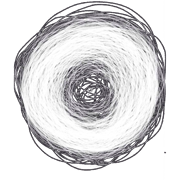| Strotter | The "Strotter" in the decade before World War II were fishing in the canalisation for stocked fat to sell it to soapcompanies. As they were standing on the edge of society, today Strotter Inst. stands on the edge of art and music, working with stuff thrown away by others | ||
| Strotter Inst.rument | The anacronistic machineries have dual roles as objects and as instruments. The first live impact is as installations, then the sounds start to grab the listeners' attention. The auditive level surpasses the visual one. Therefore, the optical comprehension of how the sound is generated plays an important role. Hardly using sounds from LP's - if so, they are cut or scotched – the main source of sound are the prepared pick-ups (i.e. sewing needles or strings instead of the diamond or the extended use of rubber bands). The treatment involves the unclean nature of the sounds as part of the music. Besides the work as a musician, Strotter Inst. is creating sound objects and installations out of turntables. The abbreviation "Inst." can both mean: "instrument" or "installation". | ||
| Strotter Inst.allation | The anacronistic machineries have dual roles as instruments and as objects. The objects and installations are putting the focal point on the static presence of the turntables. Not the playing them, but their own movement and their kind of operating define the object. A second theme is creating sounds out of the conditions of the turntables and the material or shape of the records. The optical comprehension of how the sound is generated gets more and more important. The turntable is not just moving, it’s in movement itself. (The turntable gets his honour, not the dj!) If used in the insatllations, the records do not just reproduce, they are the source themselves. | ||
| Strotter Inst. Live |
Live, Strotter Inst. is generating dense sound- and rhythmstructures by using modified and manipulated lenco-turntables and various cut or scotched records. The music ranges from a low-fi rumble changing into concrete clicks and scrapes, followed by epic drones and multilayered broken beats to fall back into tricky bass-meditations. The anacronistic machineries have dual roles as objects and as instruments. The first live impact is as installations, then the sounds start to grab the listeners' attention. The auditive level surpasses the visual one. Therefore, the optical comprehension of how the sound is generated plays an important role. In spite or probably because of the analogue creation the structures produce a contemporary and accurate athmosphere in space and time. Strotter Inst. prefers to play in the middle of the audience. The installation is set up especially for each room. Except for the PA, Strotter Inst. brings along all the material he uses. | ||
| solo | Strotter Inst., since 1998 music and performances, since 1990 installations and painting, since 1985 |
||
| projects | Glauser Strotter, 2013-2015 Gebr. Ritalin, since 2011 Sum of R, 2007-2010 Durchdrehen, since 2006 Helios & Hess, formerly known as OP Rechts & Hess, since 1999 Herpes ö DeLuxe, since 1995 Veitstanz, 1991-1996 Melanalchoholics, 1990-1997 |
||
| collaborations in music |
Patricia Kopatchinskaja (MOL/CH), Anthony Romaniuk (AUS), Alfonso Noriega (ESP), Micheal Arbenz (CH), Jorge Sanchez-Chiong (VEN/AT), Hugues Vincent (F), Kumi Iwase (JP), Vladimir Kytliar (RU), Usui Yasuhiro (JP), HSI-Chang Lin (US), Hans Koch (CH), Martin Schütz (CH), Maja Ratkie (N), Ralph Wehowsky (D), Darsombra (US), Tasaday (I) Sudden Infant (CH), Andy Guhl (CH), Petr Ferenc (CZ), Jürgen Eberhard (D), Tasaday (I), Andreas Glauser (CH), Flo Kaufmann (CH), Reverend BeatMan (CH), OP Rechts (CH), Monsigniore Dies (CH), David Cotner (US), Trixa Arnold (CH), Christian Müller (CH), Enrico Lenzin (CH), Hans Thammen (US), Mich Meienberg (CH), Marius Bürgisser (E), Veitstanz (CH), Rm74 (CH) | ||
| collaborations in dance |
Renate Graziadei & Arthur Stäldi (D), Michael Oberer (CH), Marcel Lehmann (CH), Monika Klingler (CH), Judith Huber (CH), freies Tanzensemble „Bufo Makmal“ (CH), collective barabare & Philharmonie Argovia(CH) | ||
| collaborations in performance |
Monsignore Dies (CH), Pavel Schmidt (D), Armin Heusser (CH), Melchior Prisi (CH), OP Rechts (CH), Sürü Zurbrügg (CH), Roger Ziegler (CH), Gerhard Jaschke (AT) & Erika Achermann (CH) | ||
| collaborations in film music |
"Unicorns Eat Gras", Poison Bobby, 2017 "PS: Episoden & Gedichte", Insert Film, 2014 "Stotter Inst", Ingwer Bergmann, 2001 "Flausens", rag, 1999 "PositivNegativ", G-Werk "Foetus", 1998 |
||
| prizes | Prize for Music by the Canton Berne, 2017 Residency at Cité des Art Paris, 2015 Prize for Art „Regiobank“ Solothurn, 2010 Prize for Art of Canton Solothurn, 2008 |
||
